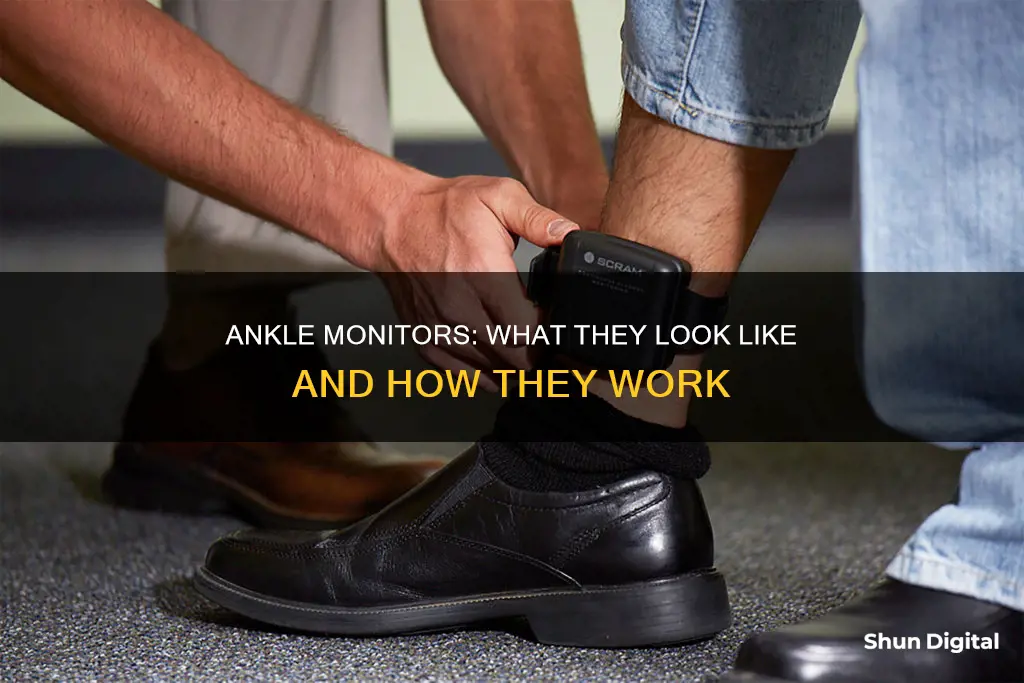
GPS ankle monitors are an alternative to incarceration, allowing individuals to serve their sentences outside of traditional correctional facilities. These devices are typically used to monitor the whereabouts of individuals on probation or parole. They are equipped with GPS technology, which enables authorities to constantly track the wearer's movements and position. The GPS ankle monitor uses signals transmitted from GPS satellites to detect the wearer's location, speed, and direction of movement. This real-time tracking is further enhanced by geo-fencing, which allows for the creation of virtual boundaries. While the design of these devices may vary, they generally consist of a GPS module, a cellular module for data transmission, and an electronic strap for secure attachment. These components are designed to be tamper-proof, and the wearer is often responsible for ensuring the device remains charged. Although GPS ankle monitors offer a reliable tracking solution, certain factors such as environmental conditions and signal interference may affect their accuracy.
| Characteristics | Values |
|---|---|
| Appearance | Typically, a GPS ankle bracelet is a physical device with a GPS module, a cellular module for data transmission, and an electronic strap for secure attachment. |
| Technology | GPS ankle bracelets use GPS technology to monitor the wearer's movements and position by leveraging signals transmitted from GPS satellites. |
| Data Transmission | Cellular networks are used by GPS ankle bracelets to transmit location data to monitoring stations and centres. |
| Alerts | Alerts are triggered when an individual wearing the ankle bracelet violates a predefined boundary, and this real-time monitoring enables authorities to respond promptly. |
| Charging | GPS ankle bracelets rely on battery power and individuals wearing them are generally responsible for charging the device themselves. |
| Accuracy | Environmental conditions, such as thick buildings or dense foliage, and signal interference from electronic devices may affect the accuracy of GPS ankle bracelets. |
| Privacy | The use of GPS ankle bracelets raises privacy concerns as it involves constant oversight of an individual's movements. |
What You'll Learn

How GPS ankle monitors work
GPS ankle monitors are a common sight in today's justice system, serving as a tool for monitoring individuals who are subject to legal restrictions. These devices allow authorities to keep track of individuals without the need for incarceration.
A GPS ankle monitor is affixed to the ankle of the wearer 24 hours a day and is typically waterproof, shock-resistant, and tamper-proof. It consists of a GPS module, a cellular module for data transmission, and an electronic strap for secure attachment. Accompanying the hardware is a software system that manages data collection and analysis, processing location data received from satellites and generating reports or alerts for law enforcement.
GPS ankle monitors utilise global positioning system (GPS) technology, a satellite-based navigation system that enables accurate positioning and tracking on a global scale. The device receives signals from multiple GPS satellites orbiting the Earth and, by analysing the timing and strength of these signals, it can estimate the distance between the wearer and each satellite. Through a process called trilateration, the device determines the wearer's precise location by intersecting the calculated distances from at least three satellites. This information is then transmitted to monitoring stations via cellular networks, allowing for real-time tracking and prompt responses to potential violations.
The monitors often employ a feature called geo-fencing, which allows for the creation of virtual boundaries or zones within which a wearer is permitted or restricted. If an individual wearing the ankle bracelet violates a predefined boundary, an alert is triggered and immediately transmitted to monitoring stations, enabling authorities to respond promptly.
While GPS ankle monitors offer reliable tracking capabilities, certain factors may affect their accuracy, such as environmental conditions (thick buildings, dense foliage, or underground locations) and signal interference from other electronic devices. Additionally, the devices rely on battery power, which requires regular recharging by the wearer.
In conclusion, GPS ankle monitors provide a balance between constant oversight and the wearer's freedom within prescribed boundaries. They offer an alternative to traditional incarceration, allowing for enhanced supervision and monitoring of an individual's whereabouts, especially when they need to leave an approved residence or when a third-party risk has been identified.
Enhancing Your ASUS GeForce GT 710 Monitor Experience
You may want to see also

Who has to wear them
Ankle monitors are typically worn by people who are out on bail awaiting trial, on probation, or on parole. They are often used as an alternative to pre-trial detention or jail sentences for low-risk offenders, allowing them to remain free while ensuring they don't get into more trouble. Here are some specific scenarios where a court may order the use of an ankle monitor:
- Flight Risk: If the court considers an individual a flight risk, they may be required to wear an ankle monitor to ensure they don't leave the designated area. This helps guarantee their appearance in court and prevents them from fleeing prosecution.
- Serious Crimes: For offences like murder, sexual assault, or major drug offences, courts might mandate the use of an ankle monitor as a condition of bail or parole. This provides an extra layer of supervision and protection for the community.
- Repeat Offenders: Individuals with a history of reoffending or violating bail or parole terms may be subject to ankle monitoring. This additional supervision helps prevent them from committing further crimes and ensures their compliance with court orders.
- Domestic Violence: In cases of domestic violence, ankle monitors can enforce protection orders by ensuring that the offender maintains a required distance from the victim. This provides a sense of safety and security for the victim.
- Driving Under the Influence (DUI) or Driving While Intoxicated (DWI): Multiple DUI or DWI offences may result in the court ordering the use of an ankle monitor. These monitors can also detect alcohol levels through sweat analysis, ensuring compliance with court orders to refrain from drinking.
- Immigration Cases: In some instances, individuals awaiting court dates for immigration proceedings, including those facing potential deportation, may be required to wear ankle monitors.
- Community Control or House Arrest: Ankle monitors are often used when an individual is placed under house arrest or community control. This allows the authorities to ensure that the person remains within the designated geographical boundaries.
It is important to note that the use of ankle monitors and the specific conditions attached to them can vary based on jurisdiction, the severity of the crime, and the individual's criminal history. Additionally, the cost of wearing an ankle monitor can be a significant burden, with fees for installation and daily monitoring adding up to hundreds of dollars per month.
Choosing the Right Monitor Size for Recording Studios
You may want to see also

The cost of GPS ankle monitors
GPS ankle monitors are often touted as a cost-effective alternative to incarceration, but the reality is that they can be incredibly expensive for those who have to wear them. While private probation and monitoring services claim to offer flexible payment plans and cost-effective alternatives, the financial burden of GPS ankle monitors falls on the parolee or defendant, who often already has limited financial resources.
In the United States, defendants who have not been convicted of a crime are sometimes put on "offender-funded" payment plans for GPS monitors, which can cost more than bail. A 2014 study by NPR and the Brennan Center found that every state except Hawaii required people to pay at least part of the costs associated with GPS monitoring. The setup fee for ankle monitors can range from $175 to $200, and the daily fee can be anywhere from $5 to $40. These fees can quickly add up, especially for those who are indigent or struggling financially. In some cases, people may be forced to wear ankle monitors for years or even for life, racking up thousands of dollars in fees.
The high cost of GPS ankle monitors can lead to a cycle of debt and unemployment. The ankle monitor itself, as well as the frequent check-ins with monitoring companies, can make it difficult for parolees to find and keep a job. According to a 2011 survey by the National Institute of Justice, 22% of people on electronic monitors said they had been fired or asked to leave a job because of the device. The stigma associated with wearing an ankle monitor can also cause parolees to feel embarrassed or ashamed, leading them to isolate themselves and further impacting their ability to find employment.
In addition to the direct costs of the ankle monitor, there are also indirect costs associated with charging and maintenance. GPS ankle monitors require daily charging, which can be inconvenient and time-consuming for parolees, especially if they are working or socialising. The devices also need to be maintained and repaired, which can add to the overall cost.
While GPS ankle monitors can provide an alternative to incarceration, reducing jail overcrowding and saving costs for the justice system, they can also place a significant financial burden on those who are already vulnerable. This can lead to a cycle of debt and unemployment, impacting not just the parolee but also their families and communities. It is important for policymakers and criminal justice reform advocates to consider the true cost of GPS ankle monitors and work towards finding solutions that are truly cost-effective and fair for all involved.
Is Your Slack Being Watched? Here's How to Tell
You may want to see also

The pros and cons of GPS ankle monitors
A GPS ankle monitor is a device strapped to the ankle to track an individual's movement and location. They are usually about the size of a pager and are strapped with a tamper-proof band.
The Pros of GPS Ankle Monitors:
- Enhanced Security and Safety: GPS ankle monitors allow for real-time location tracking, which can facilitate rapid response in emergencies or accidents. This is especially useful for employees working in potentially hazardous environments, such as construction, mining, or offshore operations.
- Asset Management: GPS ankle monitors can also be used to track valuable assets and equipment, in addition to personnel monitoring. This helps safeguard against theft and aids in prompt recovery in case of loss.
- Improved Accountability: In remote work or field operations, GPS ankle monitors ensure employee accountability and enhance operational productivity.
- Efficient Resource Allocation: By tracking employee movements and task completion, businesses can optimize resource allocation and make informed decisions.
- Alternative to Incarceration: GPS ankle monitors provide an alternative to jail sentences, allowing non-violent offenders to serve their sentences outside of correctional facilities. This helps reduce jail overcrowding and costs.
- Rehabilitation and Reintegration: Individuals wearing ankle monitors can continue their daily routines, improve social and vocational skills, and maintain employment while being monitored. This promotes rehabilitation and increases the chances of successful reintegration into society.
- Supervision of High-Risk Individuals: GPS ankle monitors are useful for supervising high-risk individuals, such as sex offenders, violent offenders, and domestic violence cases. This enhances community safety.
- Compliance with Court Orders: Ankle monitors help ensure compliance with court orders, such as maintaining a required distance from victims in domestic violence cases or refraining from drinking alcohol in DUI cases.
- Reduced Bail Amounts: Agreeing to wear an ankle monitor can result in lower bail amounts or even no bail, as it assures the court that the individual will not flee.
The Cons of GPS Ankle Monitors:
- Privacy Concerns: GPS ankle monitors can potentially invade personal privacy, making employees or individuals uncomfortable with constant monitoring. This can lead to decreased morale and even legal challenges if not managed transparently.
- Data Security: There are inherent risks related to data security and unauthorized access to sensitive location data.
- Operational Costs: The purchase, maintenance, and management of GPS ankle monitor technology incur significant costs, including initial investment and ongoing data subscription fees.
- False Positives and Negatives: GPS ankle monitors may occasionally yield false positives or false negatives, leading to misunderstandings and undermining the system's reliability.
- Discomfort and Restriction: Wearing an ankle monitor can be restrictive and uncomfortable. Individuals may need to take extra measures, such as wearing loose-fitting clothing and using lotion to prevent skin irritation.
A Simple Guide to Disabling Monitor Aiming Point Feature
You may want to see also

Privacy concerns
The use of GPS ankle bracelets has raised legitimate privacy concerns. Balancing societal interests in public safety and the need to rehabilitate individuals with their right to privacy is crucial.
The use of GPS technology in ankle bracelets raises questions about the extent of government surveillance and the potential for misuse of personal data. While the bracelets are designed to monitor individuals subject to legal restrictions, the constant tracking and collection of location data may be seen as an invasion of privacy. The data collected by these devices is extremely detailed and can provide insights into an individual's daily routines, patterns of movement, and personal habits.
To address these concerns, authorities typically implement GPS ankle bracelets within a strict legal framework that outlines specific guidelines and procedures for their use. Safeguards are put in place to ensure privacy protection, such as limiting access to location data to authorized personnel only. Additionally, the deployment of GPS ankle bracelets must align with local laws and regulations, providing a fair and transparent monitoring process while respecting the privacy rights of the individuals being tracked.
The effectiveness of these privacy protections depends on consistent enforcement and oversight. It is important for the public to have confidence that their data is secure and will not be used for unauthorized purposes. Regular audits and accountability measures are necessary to ensure that the use of GPS ankle bracelets does not infringe on the privacy rights of individuals.
Furthermore, there are potential consequences for individuals beyond the scope of the criminal justice system. For example, the data collected by GPS ankle bracelets could be subpoenaed in civil lawsuits or used by insurance companies to adjust rates. There may also be indirect effects on the friends and family members of the person wearing the bracelet, as their locations and associations are also tracked.
In conclusion, while GPS ankle bracelets offer benefits in terms of public safety and rehabilitation, it is essential to carefully consider and address the privacy concerns they raise. The potential for misuse or overreach underscores the need for robust legal safeguards and oversight to protect the rights of individuals being monitored.
Maximizing Your Canon 6D: Keeping the LCD Monitor On
You may want to see also
Frequently asked questions
A GPS ankle monitor is a device that is affixed to the ankle of an individual who is subject to legal restrictions. It typically consists of a GPS module, a cellular module for data transmission, and an electronic strap for secure attachment. The strap is designed to be tamper-proof and shock-resistant. The device is also usually waterproof.
The key components of a GPS ankle monitor include a GPS module, a cellular module, and an electronic strap. These components work together to ensure accurate tracking and monitoring of the individual's movements.
A GPS ankle monitor utilizes GPS technology to constantly monitor and track the wearer's movements and position. It receives signals from GPS satellites and uses trilateration to estimate the distance between the wearer and the satellites, allowing for precise location detection.
GPS ankle monitors offer an alternative to incarceration, allowing individuals to serve their sentences outside of traditional correctional facilities. This helps reduce jail overcrowding and costs. It also promotes rehabilitation and reintegration by allowing individuals to maintain employment and continue with their daily routines while being monitored.
Yes, there are some concerns and limitations to consider. GPS ankle monitors may raise privacy and legal issues, as they constantly track an individual's movements. Additionally, certain factors such as environmental conditions and signal interference can affect the accuracy of the device.







